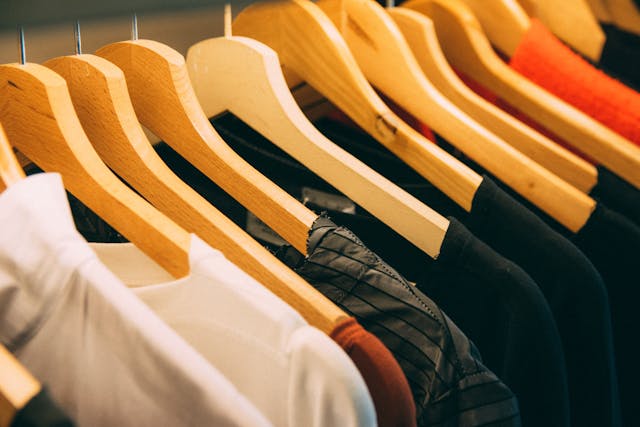The Toxic Clothing Industry
The weather is warming and summer is around the corner! Time for some new summer clothes! But wait… Do you know how these items were created? The impact they have on our environment? Do you have toxic clothing lurking in your closet? Let’s throw out some facts:
- Textile dyeing is the second largest polluter of water globally.
- It takes around 2,000 gallons of water to make one pair of jeans.
- 1.5-2.5 trillion gallons of water are used by the fashion industry each year.
- 150 billion pieces of clothing end up in landfills each year.
- The fashion industry creates 5x more co2 than the aviation industry.
- The fashion industry is responsible of 10% of the total carbon emission the world.
- It takes up to 1000 years to decompose shoes. (Imagine – the shoes you’ve worn throughout your entire life are sitting somewhere in a landfill or beach).


It gets worse…
All of the elements of fast fashion: trend replication, rapid production, low quality, and competitive pricing, add up to a large impact on the environment and the people involved in its production. Toxic clothing brands like Forever 21 and Shein use toxic chemicals, dangerous dyes, and synthetic fabrics which seep into water supplies in foreign countries (where the clothing is made) and at home when the clothing is washed.
These processes affect the humans who wear them, and the humans who make them. Some garments and accessories even have dangerous amounts of lead in them, and exposure to lead increases one’s risk of infertility, heart attacks and more. Skin is the largest organ of the body and putting on these poorly made items on it is dangerous all on its own. This danger only grows in the factories, towns, and homes which are used to produce these items.
A garment worker’s health is constantly being jeopardized through their long hours, lack of resources, exposure to harmful chemicals, and often physical abuse. The people who make fast fashion clothing have been confirmed to be underpaid, underfed, and pushed to their limits because there are often few other options.
Maybe you have, but most likely you haven’t realized that all that cheap, toxic clothing you’ve purchased was created in a factory in Bangladesh. Roughly 6 years ago, 1,134 garment workers died when their factory building collapsed in Dhaka, Bangladesh due to cracks in the building’s structure. Factory bosses forced workers to enter the building to earn a wage of $95 a month.
Toxic Clothing Choices to Avoid!
Polyester
- It takes between 20 to 200 years for polyester to break down, unlike natural textiles like silk, cotton, and wool that take only 1 year to break down.
- A single polyester garment can shed >1900 microplastic fibers per wash, which enter the water system and ultimately our oceans. Fish consume those microplastics and we consume that fish.
- A recent study in California found that 1 out of 4 fish sold in a fish market contain harmful microplastics.
- Polyester fabrics are treated with formaldehyde, PFAOs and PFCs
- Polyester chemicals can leech through your skin and disrupt your endocrine and reproductive systems and even cause cancer.
- Polyester is energy intensive to produce. It requires 8x more than linen.
- 90% of dye houses and textile factories release their waste directly into local fresh water supplies in developing countries.
- Recycled polyester (and plastic water bottles) is just as toxic to the environment and our health.
Bamboo
Yes, I said it! Bamboo is a toxic fabric you should avoid. While bamboo itself is a sustainable and quickly renewable resource, the process of turning it into fabric like rayon or viscose often involves toxic chemicals, making the final product not necessarily eco-friendly or safe. This processing can lead to air and water pollution, including the release of chemicals like sulfur, nitrous oxides, and chlorine compounds.
Carbon Disulfide is highly toxic and has been linked to severe health issues, including damage to the lungs and nervous system. Sodium Hydroxide and Sulfuric Acid are highly corrosive and can irritate or even burn the skin and lungs. As a result, working conditions in bamboo viscose factories are very dangerous, and excess chemicals from the production process often leak into the environment, polluting the air and water.
Rayon (Viscose)
See “Bamboo” above. To produce rayon, highly toxic solvents are applied to wood pulp to break it down into purified cellulose. The hazardous chemicals required — like carbon disulfide — pose serious health risks for factory workers, including potential damage to reproductive and nervous systems. And because of the large quantities of necessary chemicals, residual toxins are emitted into the environment, polluting air and water. The entire process is also water- and energy-intensive, further depleting the Earth’s already limited resources.
Nylon
Potential toxic additives to nylon textiles include azo dyes, dyes with Chromium, Aluminum additives, Antimony, nanoparticles, ethoxylated chemicals (which can be contaminated with 1,4 dioxane), bisphenols, halogenated antimicrobials, and potential treatments like PFAS and flame retardants.
Nylon manufacturing creates nitrous oxide, a greenhouse gas 310 times more potent than carbon dioxide. It’s is created from petro chemicals and create microplastic pollution.
Acrylic
Acrylic fabrics are made of acrylonitrile, which is a carcinogen and a mutagen. Exposure to this substance can cause different problems with your health. Among them are headache, nausea, dizziness, difficulty breathing, limb weakness, and many more. By wearing acrylic fabrics, you run the risk of absorbing some of the acrylonitrile into your skin.
Also, the manufacturing of acrylic is a huge cause of environment pollution.
Spandex/Lycra/Elastane
Like other synthetic fabrics, these are made from harmful chemical substances like polyurethane, that is also considered to be a carcinogen. Repeated exposure to polyurethane can cause damage to the kidneys, liver, brain, and bone marrow. Some chemicals found in spandex, like BPA and PFAS, are known as endocrine disruptors, meaning they can interfere with the body’s hormone system. Prolonged contact with these fabrics can also cause skin irritations like dermatitis. Research suggests that sweat can help chemical additives leach out from synthetic fibers, making them available for absorption through the skin.
“Fashion is not something that exists in dresses only. Fashion is in the sky, in the street, fashion has to do with ideas, the way we live, what is happening.”
Coco Chanel
Non-Toxic, Ecofriendly Clothing Choices
Choose Used
So maybe that is enough ranting about the toxic clothing industry. Let’s talk about what would happen if everyone bought just one used item instead of new this year. We would save:
- 5.7 billion pounds of co2 emissions – equivalent to half a million cars taken off the road for a year.
- 11 billion kwh of energy – that’s the amount of energy it would take to light up the Eiffel tower for 141 years!
- 25 billion gallons of water – you know those Bellagio fountains in Vegas? That would fill 1,140 of them.
- 449 million pounds of waste – the weight of 1 million polar bears!
Buying used is easy at thrift stores and consignment stores. But sometimes shopping at thrift stores can feel a little dirty. And consignment stores may be too far away, too expensive, or not your style.
My favorite online second-hand store is thredup (use this link to get 45% off and free shipping). Their website is super easy to navigate, and their phone app is even better! They have over 2 million items to choose from for women and kids with over 40,000 new items every day. Plus, it is so easy to sell your old stuff! Pack it all in a box and send it to the company for free! If your item is too worn for wear, it gets donated or recycled. Items that sell put a credit in your account!
Ebay is also a great outlet to find used items for sometimes half the cost!
Choose Natural
- 100% organic cotton – Organic cotton farming avoids synthetic pesticides, herbicides, and fertilizers, protecting soil, water, and air quality.
- Wool – Sheep can be shorn annually without harming them, making wool a sustainable and renewable resource. It’s biodegradable, warm, and hypoallergenic.
- Hemp – Hemp clothing offers numerous benefits, including durability, breathability, and sustainability, making it a great choice for eco-conscious consumers who value comfort and longevity. Hemp plants absorb more carbon dioxide from the atmosphere than most other plants, making them a carbon-negative material.
Where to Shop
If you must buy new, search for eco-friendly, sustainable stores online. My favorites include:
- Fair Indigo – fair trade and 100% organic cotton. Coupon code THEYINLIFE
- Pact – 100% organic cotton
- Rawganique – 100% organic cotton, linen, and hemp
- Woolly – Merino wool, sustainably and responsibly harvested
- Asatre – Mostly hemp based, eco-friendly clothing
- Namarie – Sylvendel® fabric: 78% hemp and 22% bio-based elastane (made from corn)
A little bit to add…
Buy green and high-quality
You get what you pay for. Save the environment and yourself some money by buying something that will last.
Forgo toxic detergent and fabric softener. It is so freaking easy to make your own detergent. Once you finish what you have, reuse the container and fill it half full of borax and half full of washing soda (we use arm & hammer). That is literally it. If you must need some fragrance, add some shavings of bar soap into the mix. You’ll save the environment and some money!
For fabric softener, simply pour half a cup of white vinegar into the fabric softener dispenser in your washing machine (or put it in during the rinse cycle if your washer doesn’t have one). To get your clothes smelling extra sweet, add six drops of essential oil like lavender or lemongrass to a scrap of cotton from an old shirt, and toss in the dryer.
Do not dry clean! Conventional dry cleaning requires the use of perchloroethylene, a nasty recognized carcinogen that’s also a suspected neuro-, reproductive-, respiratory-, developmental-, kidney-, skin-, and gastrointestinal-toxicant. You can get away with washing silk and wool items at home. Follow bond’s instructions here. If you need to have an item professionally cleaned, look for wet cleaners and co2 cleaners, which use less-toxic, perc-free methods. Find one at nodryclean.com.
Toxic Clothing Documentaries
Watch The True Cost on Netflix to learn more about the fast fashion industry.
Watch Stink! On Netflix to learn about the toxic chemicals in your clothing.

If you made it all the way to the end, I salute you! Thank you for taking the time to care. Please share your favorite ecofriendly, non-toxic, sustainable clothing options!

0 Comments